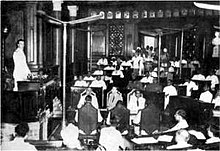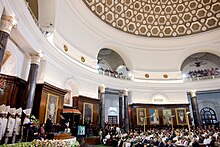Old Parliament House, New Delhi
| Sansad Bhavan | |
|---|---|
संसद भवन | |
 Sansad Bhavan, seen from Rajpath | |
| General information | |
| Town or city | New Delhi |
| Country | India |
| Construction started | 1912 |
| Opened | 1927 |
| Owner | Government of India |
| Design and construction | |
| Architect(s) | Edwin Lutyens and Herbert Baker |
Sansad Bhavan is the house of the Parliament of India, located in New Delhi.
History
Originally called the House of Parliament, it was designed by the British architect Edwin Lutyens and Herbert Baker in 1912-1913 and construction began in 1921. The opening ceremony of the Parliament House, then called the Central Legislative Assembly, was performed on 18 January 1927 by Lord Irwin, the then Viceroy of India. The third session of Central Legislative Assembly was held in this house on 19 January 1927.[1]
The Parliament Museum, opened in 2006, stands next to the Parliament House.
Building

The shape is circular, which is based on the Ashoka Chakra. Separate halls were constructed for the sessions of the Chamber of Princes, the State Council, and the Central Legislative Assembly.
The building is surrounded by large gardens and the perimeter is fenced off by sandstone railings (jali) modeled after the Great Stupa of Sanchi.
Central Hall

The Central Hall of the Parliament is designed to be circular in shape. The dome is 98 ft. (29.87 metres) in diameter and is believed that it is one of the most magnificent domes in the world. The Central Hall is a place of historical importance in India for two reasons: The transfer of colonial power to the Provisional Government under Nehru in 1947 and the framing of the Constitution by the Constituent Assembly took place in this very hall. Originally, the Central Hall was used as the Library of the erstwhile Central Legislative Assembly and the Council of States until 1946, when it was converted and refurnished into the Constituent Assembly Hall. The Constituent Assembly met there from December 9, 1946 to November 26, 1949 to draft the constitution. At present, the Central Hall is used for holding Joint Sittings of the two Houses. At the commencement of the first session after each General Election to Lok Sabha and at the commencement of the first session of each year, the President addresses both the Houses of Parliament assembled together in the Central Hall. When the Houses are in session, the Central Hall is used by Members for informal discussions among themselves. Central Hall is also used for special occasions when the Members of Parliament are addressed by distinguished Heads of States of other countries. The Hall is also equipped with Simultaneous Interpretation System.
Proposal for a new building
A new Parliament building may replace the existing complex. The new building is being considered on account of the stability concerns regarding the current complex.[2] A high powered committee to suggest alternatives to the current building has been set up by the Speaker, Meira Kumar. The present building, an 85 year old structure suffers from inadequacy of space to house members and their staff and is thought to suffer from structural issues. The building also needs to be protected because of its heritage tag.[3]
2001 Parliament attack
On 13 December 2001, the building of the Parliament was attacked by five Lashkar-e-Toiba and Jaish-e-Mohammed terrorists. In addition to all the attackers, six military personnel and one civilian were killed.[4]
See also
References
- ^ "History of the Parliament of Delhi". delhiassembly.nic.in. Retrieved 13 December 2013.
- ^ "Delhi may see a new Parliament building". timesofindia.indiatimes.com. 13 July 2012. Retrieved 13 December 2013.
- ^ Firstpost (2012-07-13). "Speaker sets up panel to suggest new home for Parliament". Firstpost. Retrieved 2012-08-15.
- ^ "Terrorists attack Parliament; five intruders, six cops killed". rediff.com. 13 December 2001. Retrieved 13 December 2013.
External links
![]() Media related to Old Parliament House, New Delhi at Wikimedia Commons
Media related to Old Parliament House, New Delhi at Wikimedia Commons

